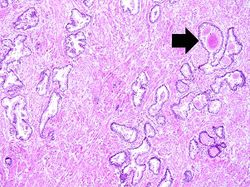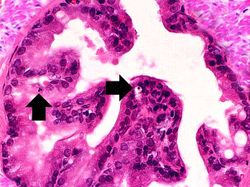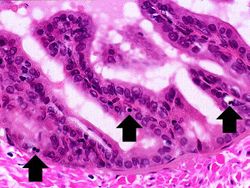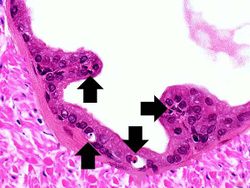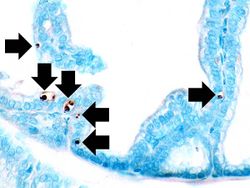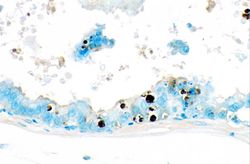Difference between revisions of "IPLab:Lab 1:Prostate"
Seung Park (talk | contribs) |
(→Autopsy Findings) |
||
| (4 intermediate revisions by 2 users not shown) | |||
| Line 1: | Line 1: | ||
== Clinical Summary == | == Clinical Summary == | ||
| − | This 68-year-old man with a 7-year history of prostatic carcinoma developed metastases to the bones of the pelvis and lumbar spine which produced significant pain and discomfort. He was treated with androgen deprivation therapy to slow the growth of the tumor and decrease the size of the tumor metastases in order to help relieve his bone pain. | + | This 68-year-old man with a 7-year history of prostatic carcinoma developed metastases to the bones of the pelvis and lumbar spine which produced significant pain and discomfort. He was treated with androgen deprivation therapy to slow the growth of the tumor and decrease the size of the tumor metastases in order to help relieve his bone pain. Two months after starting the androgen deprivation therapy, the patient experienced an acute myocardial infarction and died suddenly. At autopsy there was evidence of cancer in the peripheral region of the prostate gland and there were metastases present in the pelvis and lumbar spine. The patient also had moderate testicular atrophy. |
| − | |||
| − | |||
| − | At autopsy | ||
== Images == | == Images == | ||
| − | + | <gallery heights="250px" widths="250px"> | |
| − | + | File:IPLab1Prostate1.jpg|This is a low-power photomicrograph of a normal area from this patient's prostate. Note the corpora amylacea (arrow). | |
| − | + | File:IPLab1Prostate2.jpg|This high-power photomicrograph of the prostatic epithelium shows occasional cells with pyknotic fragmented nuclei (arrows). | |
| − | + | File:IPLab1Prostate3.jpg|Another high-power photomicrograph of the prostatic epithelium shows cells with pyknotic and fragmented nuclei (arrows). Note that the cytoplasm is condensed and hypereosinophilic. | |
| − | + | File:IPLab1Prostate4.jpg|Still another high-power photomicrograph of the prostatic epithelium demonstrates cells with pyknotic and fragmented nuclei (arrows). Again note the condensed and hypereosinophilic cytoplasm. | |
| − | + | File:IPLab1Prostate5.jpg|This photomicrograph of prostatic epithelium demonstrates an in situ immunohistochemical technique that is used to identify the DNA fragments characteristic of apoptotic nuclei. This technique, terminal deoxynucleotidyl transferase-mediated dUTP-biotin nick end-labeling (TUNEL) is used to identify apoptotic cells (arrows) in histology sections. | |
| − | | This is a low-power photomicrograph of a normal area from this patient's prostate. Note the corpora amylacea (arrow). | + | File:IPLab1Prostate6.jpg|This is a higher-power photomicrograph of prostatic epithelium with the TUNEL staining. Note the apoptotic cells (brown nuclei) in the epithelium as well as those floating freely. |
| − | + | </gallery> | |
| − | |||
| − | | This high-power photomicrograph of the prostatic epithelium shows occasional cells with pyknotic fragmented nuclei (arrows). | ||
| − | |||
| − | |||
| − | | Another high-power photomicrograph of the prostatic epithelium shows cells with pyknotic and fragmented nuclei (arrows). Note that the cytoplasm is condensed and hypereosinophilic. | ||
| − | |||
| − | |||
| − | | Still another high-power photomicrograph of the prostatic epithelium demonstrates cells with pyknotic and fragmented nuclei (arrows). Again note the condensed and hypereosinophilic cytoplasm. | ||
| − | |||
| − | |||
| − | | This photomicrograph of prostatic epithelium demonstrates an in situ immunohistochemical technique that is used to identify the DNA fragments characteristic of apoptotic nuclei. This technique, terminal deoxynucleotidyl transferase-mediated dUTP-biotin nick end-labeling (TUNEL) is used to identify apoptotic cells (arrows) in histology sections. | ||
| − | |||
| − | |||
| − | | This is a higher-power photomicrograph of prostatic epithelium with the TUNEL staining. Note the apoptotic cells (brown nuclei) in the epithelium as well as those floating freely. | ||
| − | |||
== Study Questions == | == Study Questions == | ||
| Line 47: | Line 29: | ||
=== Images === | === Images === | ||
| − | * [ | + | * [{{SERVER}}/library/index.php?/tags/146-prostate/219-adenocarcinoma PEIR Digital Library: Prostate Adenocarcinoma Images] |
* [http://library.med.utah.edu/WebPath/TUTORIAL/PROSTATE/PROSTATE.html WebPath: Prostate Pathology] | * [http://library.med.utah.edu/WebPath/TUTORIAL/PROSTATE/PROSTATE.html WebPath: Prostate Pathology] | ||
Latest revision as of 22:10, 27 June 2019
Contents
Clinical Summary[edit]
This 68-year-old man with a 7-year history of prostatic carcinoma developed metastases to the bones of the pelvis and lumbar spine which produced significant pain and discomfort. He was treated with androgen deprivation therapy to slow the growth of the tumor and decrease the size of the tumor metastases in order to help relieve his bone pain. Two months after starting the androgen deprivation therapy, the patient experienced an acute myocardial infarction and died suddenly. At autopsy there was evidence of cancer in the peripheral region of the prostate gland and there were metastases present in the pelvis and lumbar spine. The patient also had moderate testicular atrophy.
Images[edit]
This photomicrograph of prostatic epithelium demonstrates an in situ immunohistochemical technique that is used to identify the DNA fragments characteristic of apoptotic nuclei. This technique, terminal deoxynucleotidyl transferase-mediated dUTP-biotin nick end-labeling (TUNEL) is used to identify apoptotic cells (arrows) in histology sections.
Study Questions[edit]
Additional Resources[edit]
Reference[edit]
- eMedicine Medical Library: Metastatic and Advanced Prostate Cancer
- Merck Manual: Prostate Cancer
- National Cancer Institute: Prostate Cancer
- British Columbia Cancer Agency: Prostate Cancer
Journal Articles[edit]
- Denmeade SR, Isaacs JT. Programmed cell death (apoptosis) and cancer chemotherapy. Cancer Control 1996 Jul;3(4):303-309.
- Brookes PS, Salinas EP, Darley-Usmar K, Eiserich JP, Freeman BA, Darley-Usmar VM, Anderson PG. Concentration-dependent effects of nitric oxide on mitochondrial permeability transition and cytochrome c release. J Biol Chem 2000 Jul 7;275(27):20474-9.
Images[edit]
| |||||
Prostatic carcinoma is a highly metastatic form of cancer.
Back pain resulting from vertebral metastases of prostatic carcinoma is not uncommonly the presenting symptom which leads to the discovery of the carcinoma. Pain occurs late in the metastatic process and is an indicator of a poor outlook for a patient.
Myocardial infarction is necrosis of myocardial tissue which occurs as a result of a deprivation of blood supply, and thus oxygen, to the heart tissue. Blockage of blood supply to the myocardium is caused by occlusion of a coronary artery.
Most commonly, prostatic carcinoma arises in the peripheral region of the gland.
Corpora amylacea are small hyaline masses of degenerated cells and inspissated secretions. They are so named because they resemble (but are categorically not) amyloid deposits.
